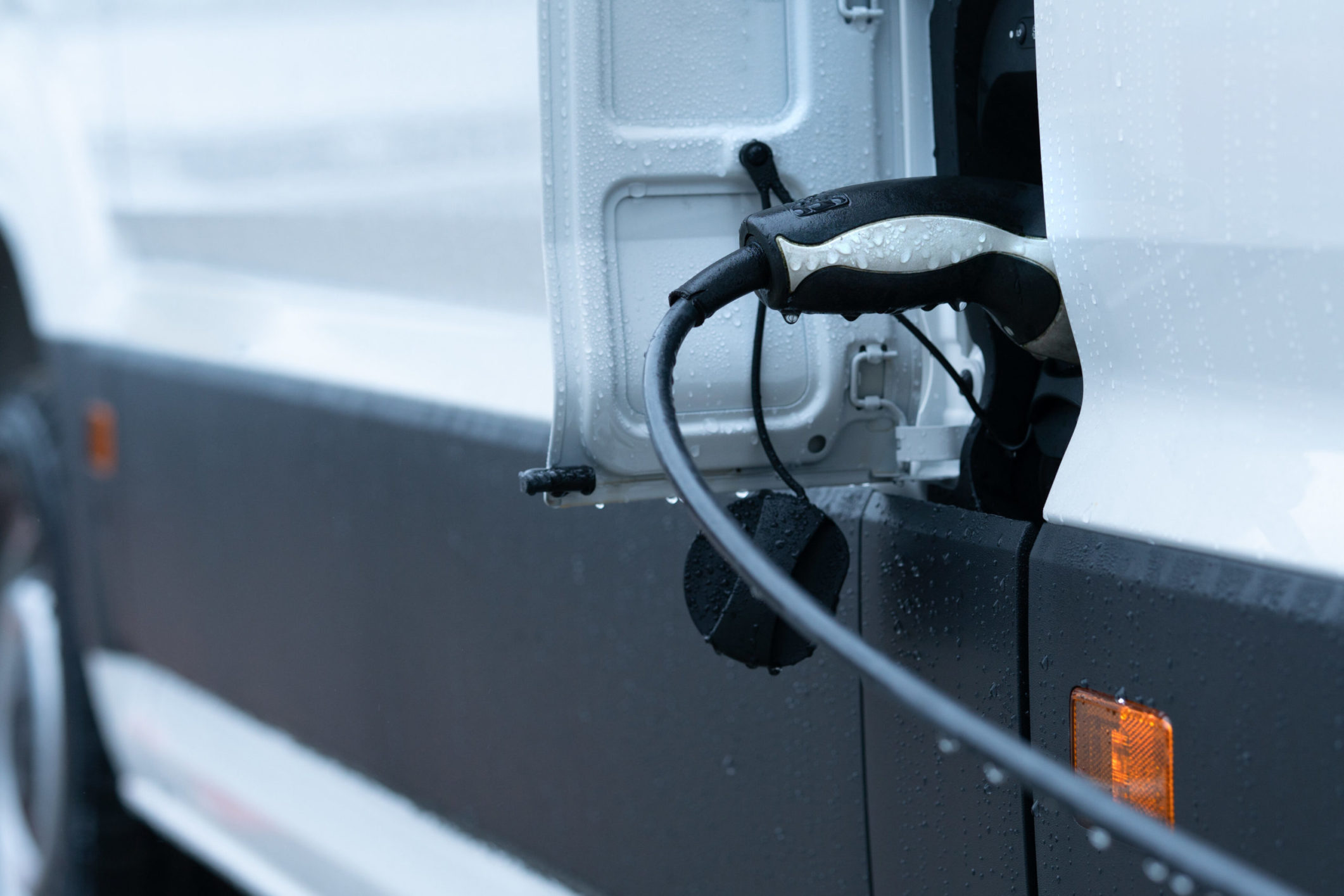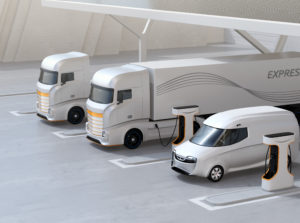Businesses operating with commercial transport have whole set of rules & processes unlike passenger cars — especially when going electric. Let’s take a look at a general overview of how electrification for business fleets is different and what you need to consider for this specific sector.
Despite seemingly lagging consumer vehicles in terms of uptake in recent years, the market for commercial electric vehicles has begun to take off. Recently, vehicle company LeasePlan crunched the numbers and said that the United Kingdom saw light commercial vehicle registrations fall between 2019 and 2020, while electric light commercial vehicles (eLCV) sales went up by 64% in the same period. Indeed, eLCV registrations in the UK jumped from 2.6% to 5.8% between 2021 and 2022. But many firms, who replace their fleet vehicles every three to four years, will probably look at an electric fleet and think, “Well, how am I supposed to charge all these? Is that even possible?”
What types of electric commercial vehicles exist?
Firstly, what is an electric commercial vehicle? Well, there are two main types: the aforementioned eLCVs and electric heavy-duty vehicles (eHDV). The former are smaller — the type of vehicle you may have seen trundling (or humming) around the middle of a city or town — and able to carry up to around 2,000 kg. An eHDV is notably larger, often referred to as a “semi” and able to carry payloads of up to 40,000 kg. These are more likely to be used to transfer goods along highways or loading and delivering at warehouses and distribution centers on the outskirts of urban areas. To put it simply: e-vans and e-trucks!
As we have written before, a number of eLCVs and eHDVs already exist on the market. The features and ranges of these vehicles vary: eLCVs have ranges of up to 400 km on a single charge with performances of around 300 HP, while eHDVs often go up to 500 km with performances of around 680 HP. One e-truck, the Futuricum Semi 40E, even set a world record for eHDV distance of 1,100 km — with extra battery stacks.
But it doesn’t stop there. Multi-purpose EVs for agriculture, forestry and mining are also emerging. These are generally like smaller tractor-trailer cabs where equipment is attached via a coupling. But have a look at Caterpillar’s heavy-duty mining dump truck to see just what’s possible. Tractors and construction EVs are slowly starting to be seen in countries leading in electrification, like Norway or China. Most of the big-name OEMs like Caterpillar, Volvo, JCB or Komatsu already have models in production. Lighter-duty mini-excavators, loaders and e-dump trucks built for off-road or urban construction sites will significantly improve air quality & noise pollution into the future.
What is different about charging commercial EVs?
There are specific differences when it comes to charging commercial fleet vehicles. To charge a smaller consumer EV such as a car is relatively simple: plug it into a wall or street charger and leave it until it is done. But it’s a different story for their larger, company-based cousins. The sheer size of a commercial vehicle means that they need larger or multiple batteries (although these are coming down both in size and price). Commercial EV battery packs can easily weigh in at 500kg each, with up to six or more needed for heavy-duty trucks. This means higher costs and special charging considerations.
However, like the entire EV market, this is changing rapidly. The cost of batteries for e-trucks are expected to fall around 60% by 2025, compared to 1997 levels — or from €500/kWh to €200/kWh. Energy density, for holding charge and therefore better range, will also increase from 80 Wh/kg to 200 Wh/kg by current projections.
Another big difference for commercial EVs is depot-based charging. Unlike wall-box passenger EV charging, fleets are geared toward charging on a company’s facility site. But charging numerous vehicles in one location places a heavy load on the electrical infrastructure of that site, making load management a concern. To manage this, firms employing depot charging for their EV fleet can use software such as our PANION Charging tool to help optimize their charging.
What are the advantages of charging software for commercial fleets?
Although chargers are equipped with their own software systems to link vehicles, chargers & charging sessions, they don’t do much more than that. It has become increasingly clear that digitalization & smart software for commercial charging operations are paramount for scaling electric fleets. Digital tools can simplify the integration of EVs & charging into existing business operations — think mixed fleets (EV & ICE), different fueling methods, power infrastructure. Software that makes the connection between assets & transport management systems greatly reduces complexity.
This is exactly what our own PANION Charging software enables. The tool simplifies complexity in energy management, charge stations and routing systems while connecting fleet EVs through a custom API. It intuitively manages costs, time, charging sessions and scheduling while monitoring infrastructure and grid limits with an algorithmic eye. Though the tool does a great deal more, the point is: data-driven software to manage charging & optimize smooth operations is essential.
How to charge an electric commercial fleet
The connectors and chargers for a commercial EV fleet are the same as for smaller consumer vehicles. There are three levels of chargers: slow, rapid and ultra-fast. A good, detailed overview of them can be seen here.
Slow chargers come with every EV purchase, with a plug designed for common household outlets handling 120 volts. Rapid chargers, meanwhile, are up to fifteen times faster but require a 208- or 240-volt circuit and need to be professionally installed. An ultra-fast charger, if you are lucky enough to have one, requires 480 volts and can charge an EV’s battery in fewer than ten minutes.
Connections, too, have also seen a level of standardisation in recent years. Volkswagen’s Electric charging for fleets acknowledges that a wide selection of variants in this area have been boiled down to two: the Type 2 (also known as a Mennekes plug) and a Combined Charging System (CCS). The former is largely standard across Europe and charges with AC. The latter is similar, but with more contacts for the faster DC charging.
The firm also writes: “In principle, electric vehicles can be charged with three-phase alternating current (AC) or with direct current (DC). For alternating-current (AC) charging, a rectifier installed in the vehicle converts the current from the public AC grid into the direct current (DC) needed for the battery; when charging with DC current, charging is regulated in the charging station.”
Where to charge an electric commercial fleet
While commercial fleets may be charged on the road, the smarter method is through infrastructure installed at depots. This depot-based charging does exactly what it says on the tin: instead of trying to find external chargers, drivers can bring their vehicles back to the depot where they can be charged on site. The obvious advantage of depot-based charging is that a fleet can be charged overnight (or between tours) on locked premises, being fully charged, set and raring to go in the morning for the next day’s tours.
Obviously, every case is different, depending on facility architecture and electrical infrastructure, EV fleet sizes, schedules and other business-specific requirements. Here it’s important to plan an electrification strategy that encompasses both vehicle electrification and charging infrastructure.
But this type of infrastructure can be expensive. IAA Transportation recently spoke with the head of Mercedes-Benz trucks eConsulting. They estimated that the cost of construction would be around €250,000 for something including a new transformer and cables from the medium-voltage ring main for five charging stations, each producing 160 kW. The price of charging stations would come on top of this.
But there is some light in the darkness here. Not only are prices going down rapidly through tech advances, policy & steps toward sustainability are making an impact. There are numerous subsidies and methods of funding available in Europe, while the US’s Bipartisan Infrastructure Law contains at least $7.5bn in funding towards building electrical vehicle infrastructure throughout America.
All of this suggests that the surge in electric commercial vehicles and the charging infrastructure rollout will continue. We’re excited to be a part of it!




